Uluru, also known as Ayres Rock, the grand monolith dominating the landscape in Australia’s red centre, has been a sacred site for Aborigines for millennia. In 1987 Uluru-Kata Tjuta, the national park where Uluru is located, was made a World Heritage site for its ‘outstanding universal natural values’; in 1994 its cultural values were also recognised by UNESCO. But in the months leading up to the ban on climbing the rock, which came in to effect on 26 October this year, Uluru has received an unusual amount of attention in the international press. It has also attracted an unprecedented number of visitors from around the world, before now perhaps not aware of its significance.
First Nations communities made up of Yankunytjatjara and Pitjantjatjara peoples (jointly known as Anangu) are the principal custodians of Uluru, while other groups from the surrounding region such as the Ngaanyatjarra, Luritja and the Arrernte peoples also have a binding relationship with this magnificent rock, which imposes itself on the landscape like no other. Traditional owners believe that the formations of Uluru were created by ancestral beings whose spirit, or Tjukurpa, still resides in the tracks and traces, called Iwari, of the rock’s texture. Paths around the base of Uluru are thought to follow the tracks of ancestral beings called Tjukaritja. These tracks and the stories that relate to them have been represented by Anangu and others for tens of thousands of years in art adorning the rock itself, in songs and dances performed in corroborees, in body paintings and through symbols expressed in sand as well as weapons such as shields and spears and on domestic utensils.
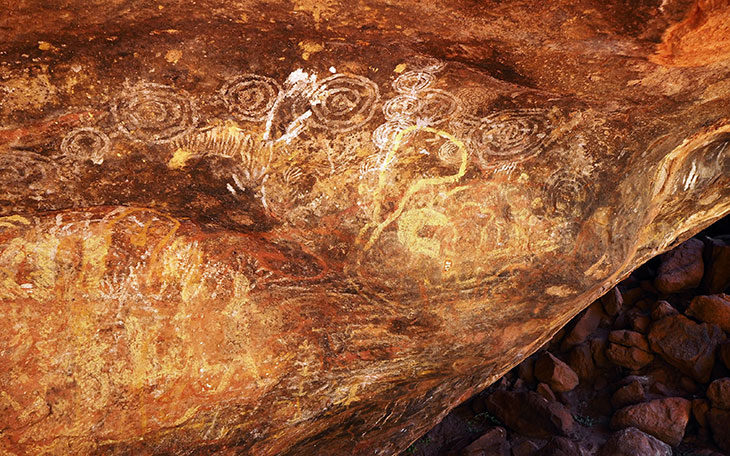
Rock art at Uluru, photographed in 2017. Photo: Kim Dingwall/Wikimedia Commons (used under Creative Commons licence [CC BY-SA 4.0])
Arguably the most spectacular work of art to come from Uluru is Rene Kulitja’s Yananyi Dreaming. Completed in 2002, it covers the entire exterior of a Qantas Boeing 737 jet. This large ‘mural’ is made up of symbols that represent the ancestral beings and the tracks they inhabit. Yananyi means going or travelling; in this work, radiating pathways painted in concentric circles lead to Uluru. The tracks of the rufous hare-wallaby (mala) emerge from the sand and the blue tongue lizard (Lungkata) basks in the hot sun.
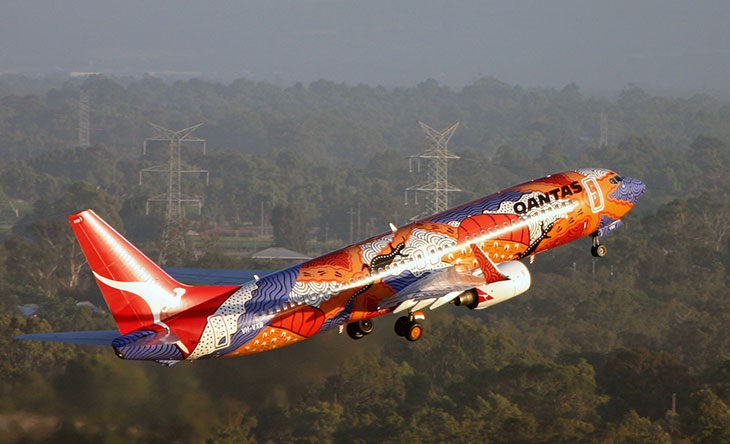
Rene Kulitja’s Yananyi Dreaming (2002) on a Boeing 737-800, commissioned by Qantas. Photo: Qantas
Kulitja is one of the new generation of female Indigenous artists and community leaders who have become prominent over the last decade. She was the lead painter of a large collaborative painting produced together with Christine Brumby, Charmaine Kulitja, and Happy Reid. It served as the support for a petition that was sent to the Australian government, urging the acceptance of what has become known as the ‘Uluru Statement from the Heart’. This document, drafted and signed by senior Indigenous elders from across Australia, called for the recognition of Aboriginal people in the Australian Constitution and for First Nations people to be allowed a voice in drafting the laws and policies that affect them. Uluru has, over the last two years in particular, become a symbol for the recognition of Indigenous Australia.
Climbing the rock is thought to entail crossing the tracks of ancestral beings and is considered to be a desecration of this living sacred site. It has been of great concern to traditional owners from the early history of European contact with Uluru. Members of William Gosse’s expedition to Central Australia in 1873 camped near its base and are believed to have traversed part of the rock by camel with the assistance of Afghan cameleers. Gosse saw the ceremonial significance given to it by local people and noted in his diary that it was the ‘most wonderful natural feature [he] had ever seen’. It was not until 1948 that a road was built to provide access to the region and groups of tourists began to arrive. Over the next decades, Anangu began to resist the intrusion on their lands and in 1971 held meetings to express their dissatisfaction. More than a decade later, Anangu elders petitioned Queen Elizabeth II and after a lengthy process of consultation, the governor-general, Ninian Stephen, handed the title deeds of Uluru to the traditional owners on 26 October 1985.

Photo: Saeed Khan/AFP via Getty Images
Although Uluru had been ‘handed back’ the terms of this saw to it that the Government of the Northern Territory received most of the revenue from the national park, while many of the traditional owners lived in poverty. Despite the clear wishes of elders, and the fact that tourists continued to die scaling the rock, climbing proceeded apace. Pressure continued to mount, however, until in 2010 the board of management of the park announced that it would close the track once the proportion of visitors to Uluru who chose to climb the rock fell below 20 per cent. In November 2017, the board voted unanimously to ban climbing Uluru, effective from 26 October 2019.
The celebrations that accompanied the closure of the walking track on that day included the performance of corroborees, dancing and singing in which Anangu and those from other communities, ranging from the youngest to the oldest, were there in force. Members of the famous Central Australian Aboriginal Women’s Choir performed songs originally brought to the region by missionaries from the Lutheran Church, who translated their German hymns into Pitjantjatjara and Arrernte. This was a milestone moment not only for the traditional owners of Uluru, who expressed their deep regret that the Australian prime minister was unable to attend, but also for the many other Indigenous and non-Indigenous supporters at home and abroad who continue to stand behind them.
Unlimited access from just $16 every 3 months
Subscribe to get unlimited and exclusive access to the top art stories, interviews and exhibition reviews.

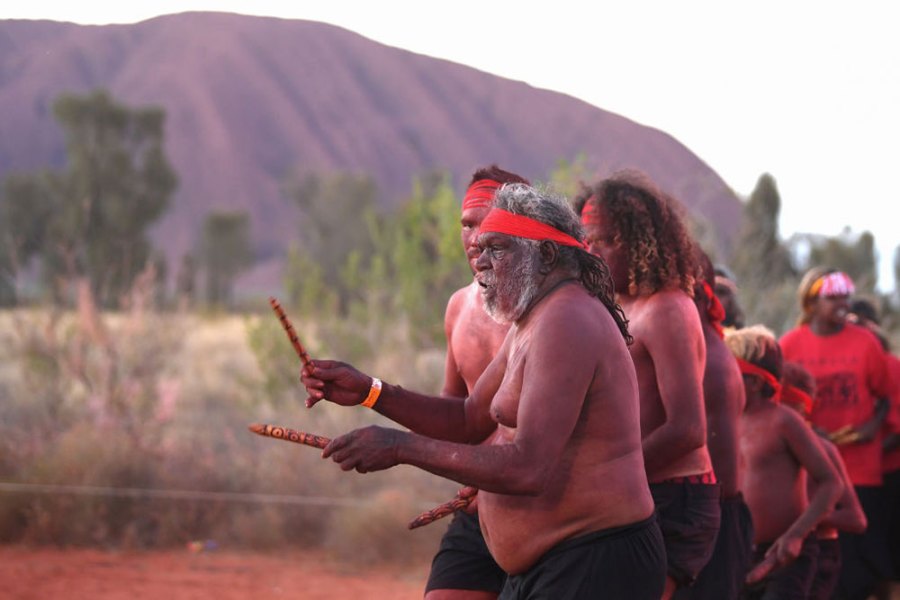
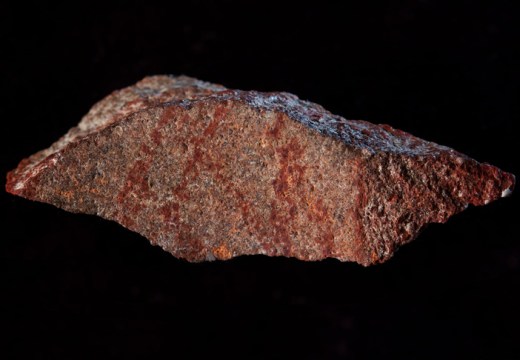
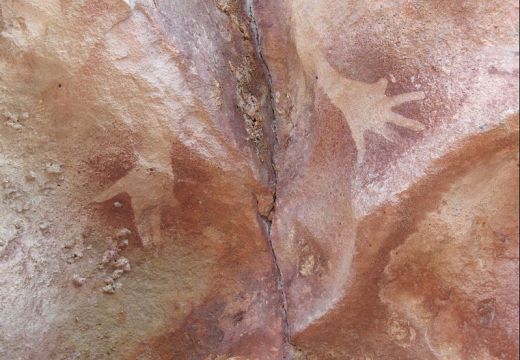
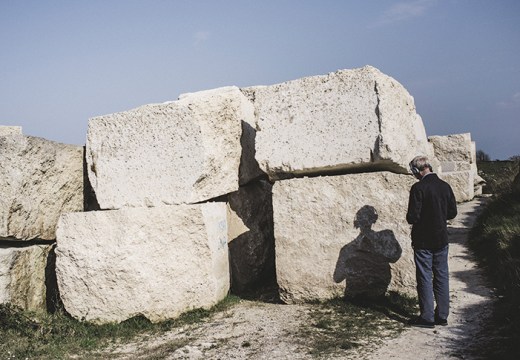









![Masterpiece [Re]discovery 2022. Photo: Ben Fisher Photography, courtesy of Masterpiece London](http://www.apollo-magazine.com/wp-content/uploads/2022/07/MPL2022_4263.jpg)
Why are fathers so absent from art history?